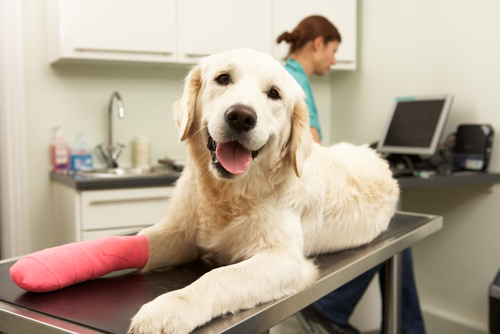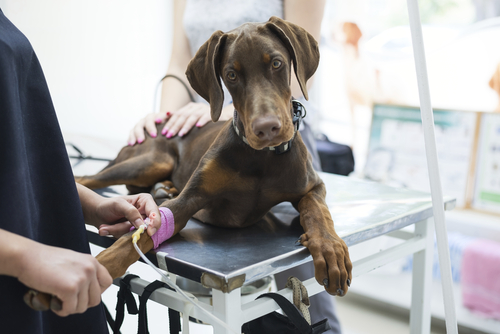
You buy high-quality dog food, keep up with regular veterinary visits, and vaccinate your pup against infectious diseases. You do everything you can think of to keep your furry BFF safe and healthy, but do you know how to perform dog first aid? Are you prepared to act if your pet stops breathing or goes into shock?
The following first aid tips could help you save your dog’s life should you face one of these eight common emergencies.

1. Wounds
While most wounds are not life-threatening, it’s important to know how to stop bleeding and apply a pressure wrap. A well-stocked dog first aid kit should contain gauze and non-adhesive wraps to apply pressure and protect the wound. Many owners also keep a muzzle in their kit since even the friendliest dogs may bite when they are in pain.
To help control bleeding, the American Veterinary Medical Association (AVMA) says to:
- Press a clean, thick gauze pad over the wound and apply pressure with your hand until the blood starts clotting (this will take a minimum of 3 minutes for larger wounds).
- For severe bleeding on the extremities, apply a tourniquet using the gauze and adhesive wrap from your first aid kit.
- Since pressure wraps minimize circulation, loosen the tourniquet for 20 seconds every 15-20 minutes.
- Seek veterinary attention immediately.
If a wound is severe enough or caused by a stressful event such as an animal attack or car accident, shock is a real and very serious possibility.

2. Shock
Shock occurs when the circulatory system fails to work properly as a result of blood loss, heart failure, anaphylaxis, extreme temperatures, or nervous system injuries. It causes a lack of oxygen to the brain, body tissues, and organs which quickly becomes a life-threatening emergency.
Signs of shock in dogs include:
- Rapid pulse
- Low body temperature
- Grey-blue mucous membranes (gums, tongue, etc.)
- Weakness and dizziness
- Nausea and vomiting
- Shallow, rapid breathing
- Gasping for air
- Eventually they will lose consciousness and stop breathing without life-saving efforts
Dog first aid steps for shock:
- Lie the dog on their right side
- Put a folded blanket under their hind end to elevate it. This encourages blood to flow to their heart and brain.
- Cover them with a warm blanket (shock causes body temp to plummet)
- Seek emergency veterinary care

3. Poisoning
In the case of toxic ingestion, call your veterinarian or the Animal Poison Control Center hotline at 888-4ANI-HELP (888-426-4435). Animal Poison Control is available 24 hours a day, 365 days a year. Have the packaging of the substance your dog was exposed to on-hand.
First aid techniques may involve inducing vomiting or seeking emergency supportive care from your vet. While some substances are best removed from the body as soon as possible, others can cause even more damage on the way out. Never induce vomiting without first seeking professional advice.
Depending on the type of exposure, you may also have to flush the eyes or thoroughly wash the skin and coat.
Do you know the most common household poisons? How about toxic foods and plants to avoid?

4. Seizures
Seizures can take on a variety of forms. Some dogs convulse violently while others experience rapid eye movement or twitching in one limb. It’s extremely frightening to witness, but canine seizures are typically not life-threatening unless they cannot be brought under control.
If your dog has a seizure, do not attempt to move or restrain them. Clear the area of potential hazards and time the length of the seizure to report to your vet.
Once the seizure has passed, your dog will most likely be listless and groggy for several hours. Keep them comfortable. If this is your dog’s first seizure, seek immediate veterinary attention. If you dog has a history of seizure disorder, follow your veterinary care plan.

5. Choking
Note: A choking, frightened dog is more likely to bite. Proceed with caution.
Many dogs cough and hack, but are not necessarily choking. To determine if your dog is in need of emergency first aid:
- Check for labored breathing.
- Gently open your dog’s mouth and see whether an object is blocking the airway.
- If visible, try to dislodge it with a hooked index finger.
- If you can’t remove the object or your dog collapses, place both hands on the side of the rib cage and apply firm quick pressure, release and repeat.
- You can also try laying your dog on its side and striking the rib cage firmly with the palm of your hand 3-4 times. (The idea behind this is to sharply push air out of their lungs and push the object out from behind.)
- Keep repeating these techniques until the object is dislodged or until you arrive at the vet’s office.
- Seek emergency veterinary care
Even if you are able to dislodge the object from your dog’s throat, you should still seek veterinary attention as soon as possible to ensure there are no further complications. Choking dogs may swallow potentially harmful substances or aspirate fluid into the lungs.

6. Apnea (Not Breathing)
You can determine if your dog has stopped breathing by watching for the rise and fall of the chest or placing your hand in front of your dog’s muzzle to feel for warm, exhaled air. Keep in mind that your dog’s respiration is slower and deeper during sleep.
If you determine that your dog is in respiratory distress, the AVMA recommends you:
- Open the airway by gently grasping the tongue and pulling it forward (out of the mouth) until it is flat.
- Check the dog’s throat to see if there are any foreign objects obstructing the airway.
- Perform rescue breathing by holding your dog’s muzzle closed and breathing directly into the nose until the chest expands.
- Once the chest expands, continue the rescue breathing once every 4 or 5 seconds.
- Be sure to check for a pulse (see video below). If absent, proceed to cardiac arrest procedures.
Ideally, these dog first aid techniques should be preformed on the way to your veterinarian’s office to seek professional treatment.

7. Cardiac Arrest (Heart Is Not Beating)
The signs of cardiac arrest are similar to those seen in the advanced stages of shock. Your dog will lose consciousness and stop breathing. Since the heart is no longer pumping oxygenated blood through the body, the mucous membranes will appear pale or blue-gray.
This is one of the most terrifying emergencies your dog can face, but with your help, they may just survive it. Prompt veterinary care is the key to a happy outcome, so be sure to perform the following rescue efforts on the way to the animal hospital.
Dog First Aid For Cardiac Arrest:
- First, check to make sure your dog doesn’t have anything blocking their airway and begin performing the rescue breathing technique from above.
- Check for a pulse (see video below).
- If no pulse, lay them on their RIGHT side so the heart is facing up. (It is located in the lower half of the chest on the left side, just behind the front left leg.)
- Place one hand underneath your dog and the other hand over their heart.
- Press down gently on the heart – about one inch down for medium-sized dogs – 100-120 times per minute.
- Alternate 30 chest compressions with two rescue breaths and check for signs of life every two minutes.
- Continue until your dog’s heart restarts or a veterinary professional is available to take over.
Learn how to assess your dog’s condition and perform these CPR techniques in the following video by pet first aid instructor Melanie Monteiro.
8. Heat Stroke
Dogs can become dangerously overheated from a boisterous day in the hot sun or being left in a hot car. Unlike humans, they only have sweat glands in their paw pads and must otherwise cool down by panting. This leaves them quite susceptible to hyperthermia. Overweight pups and those with short muzzles are even more prone to heat stroke.
Symptoms of heat stroke include:
- Excessive panting
- Drooling
- Fast or irregular heart beat
- Vomiting blood
- Muscle tremors
- Seizures
If you believe your dog is suffering from heat stroke, get them out of the heat immediately. Prompt veterinary care is essential to prevent brain and organ damage, but you can help begin the process of lowering your dog’s body temperature (slowly!) on the way to the clinic. Lowering the temp at a steady pace also helps reduce the risk of shock.
- Apply rubbing alcohol to your dog’s paw pads to help draw heat out of the body.
- Place a cool, wet towels around the body, head, and neck (avoiding the eyes, nose, and mouth).
- If possible, replace with fresh, cool towels every few minutes until your vet can take over care.

Further Your Dog First Aid Education
The more you know, the more comfortable you will be to take action in an emergency. The American Red Cross, Pet Tech, and many local animal shelters offer courses in pet first aid and CPR. You can also find additional information and resources from the professionals at the AVMA.
The post 8 Must Know Emergency Dog First Aid Procedures appeared first on iHeartDogs.com.
via Whisker Therapy